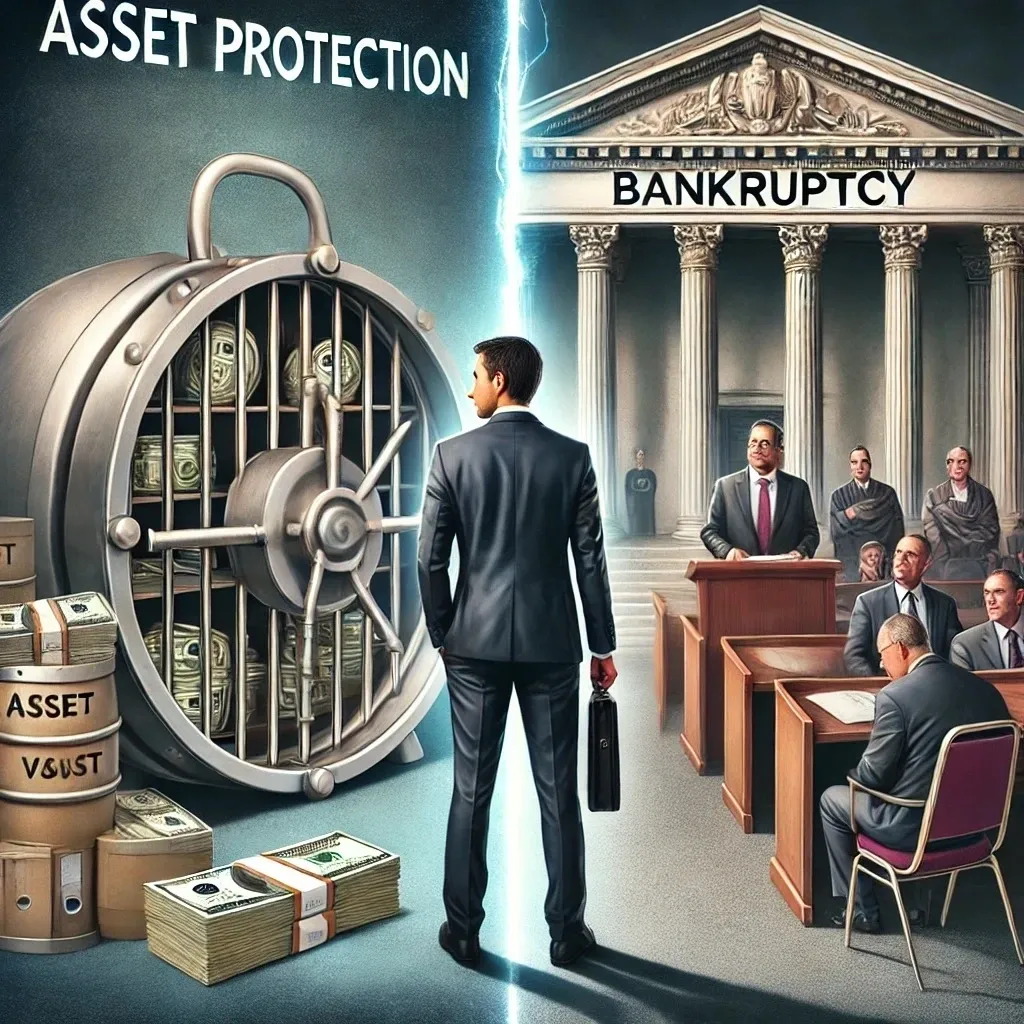A Story of Two Clients: John and Sarah
John and Sarah both faced overwhelming financial trouble. John, a real estate investor, was blindsided by a large lawsuit that threatened to take everything he had built. Sarah, a small business owner, struggled with mounting credit card debt and a failing business. Both needed a way out—but they chose very different paths.
Sarah, convinced bankruptcy was her only option, filed for Chapter 7. The process took months, involved intense scrutiny from a bankruptcy trustee, and forced her to liquidate some of her assets. At the end, her credit was wrecked, her personal reputation took a hit, and she was left with far fewer resources than she had anticipated.
John, on the other hand, consulted an asset protection attorney before making any drastic decisions. By legally structuring his assets in advance, he made it difficult for creditors to seize his property. Instead of bankruptcy, he negotiated a settlement for a fraction of what he owed. He kept his business, his investments, and his financial future intact.
Sarah’s story is all too common. Many people believe bankruptcy is the only way out of financial distress, but it often does more harm than good. Asset protection, on the other hand, focuses on preserving wealth and shielding assets from lawsuits and aggressive creditors.
Let’s break down the real differences between asset protection and bankruptcy, so you can make an informed choice when facing financial threats.
Debt Relief vs. Collection Defense: Understanding the Two Paths
When facing overwhelming debt, people tend to think of debt relief and collection defense as the same thing. But they’re not.
• Debt relief (Bankruptcy) aims to eliminate or restructure debt through legal proceedings.
• Collection defense (Asset Protection) is about preventing creditors from seizing your wealth in the first place.
Bankruptcy: The Illusion of a Fresh Start
The goal of bankruptcy is to discharge debt, but it comes with serious consequences:
• Public Record: Your bankruptcy filing becomes public, impacting future credit and business opportunities.
• Loss of Control: A bankruptcy trustee decides which assets you can keep and which must be sold.
• Court Oversight: Your finances will be under strict court supervision.
• Limited Protection: Many debts, such as tax obligations and student loans, cannot be discharged.
• Asset Liquidation: Valuable assets, including real estate and business interests, are often lost.
The 2005 Bankruptcy Abuse Prevention and Consumer Protection Act (BAPCPA) made it harder than ever to qualify for Chapter 7 bankruptcy. Creditors lobbied for stricter rules, making bankruptcy less of a safety net and more of a bureaucratic nightmare.
Asset Protection: Controlling the Negotiation
Instead of exposing all your wealth to the court, asset protection shields your assets before creditors come knocking. This strategy discourages lawsuits and often forces creditors to settle for pennies on the dollar—if they even bother to pursue the claim at all.
A well-designed asset protection trust or legal entity structure (LLCs, limited partnerships, and offshore trusts) can place your wealth out of a creditor’s reach. Unlike bankruptcy, asset protection doesn’t require a judge’s approval. You remain in control of your assets and negotiations.
Why Bankruptcy and Asset Protection Don’t Mix
Some believe they can combine both strategies—using asset protection after filing for bankruptcy. This is a critical mistake. Bankruptcy courts have broad powers to reverse transfers, dissolve trusts, and reclaim assets if they determine a debtor acted fraudulently.
Once bankruptcy is filed, most asset protection strategies become ineffective because:
• Trustees can claw back transferred assets (look-back periods often extend several years).
• Bankruptcy overrides asset protection structures, including LLCs and trusts.
• The process is unpredictable, with judges making subjective decisions.
Asset protection must be implemented in advance—before financial trouble arises. Proper planning ensures you never have to consider bankruptcy in the first place.
The Power of Negotiation in Asset Protection
Creditors often expect full payment when dealing with an unprotected debtor. But when they encounter a well-structured asset protection plan, their strategy changes.
Here’s why:
• If your assets are difficult to access, creditors often prefer a reduced settlement.
• Prolonged legal battles cost creditors time and money.
• Many creditors will walk away if they believe they’ll recover little to nothing.
Unlike bankruptcy, where the court takes control, asset protection allows you to negotiate from a position of strength. You decide when and how to settle, avoiding forced liquidation, court interference, and permanent financial damage.
Bankruptcy is a Last Resort
There are rare situations where bankruptcy may be necessary—such as stopping an immediate foreclosure or lawsuit. However, it should always be a last resort, not a first option.
If you have significant assets, a business, or a high net worth, bankruptcy will likely do more harm than good. In contrast, asset protection allows you to weather financial storms while maintaining control over your wealth.
Super Creditors vs. Normal Creditors: Who Are You Dealing With?
Not all creditors play by the same rules.
Normal Creditors
These include banks, credit card companies, and private lenders. They rely on traditional legal channels to collect debts and are often willing to negotiate settlements when faced with strong asset protection measures.
Super Creditors
Government agencies like the IRS, SEC, FTC, and state attorney generals have broader enforcement powers. They can:
• Issue liens without a court judgment.
• Freeze assets before a lawsuit is filed.
• Criminally prosecute individuals for fraud.
Asset protection still works against super creditors, but it requires more sophisticated strategies. For example, offshore trusts can provide a significant layer of security, making it extremely difficult for government agencies to seize assets.
The Final Verdict: Protect First, Then Negotiate
John’s decision to implement asset protection before financial trouble allowed him to settle his debts on his terms. He kept his business, preserved his investments, and avoided the long-term damage of bankruptcy.
Sarah, on the other hand, lost control of her financial future. The bankruptcy court decided what she could keep, creditors fought for every dollar, and she walked away with damaged credit and fewer resources.
If you’re facing financial uncertainty, don’t rush into bankruptcy. Explore your options with a qualified asset protection attorney before exposing your wealth to the courts.
Bankruptcy gives power to the courts. Asset protection puts power back in your hands.
Take Action Before It’s Too Late
At Bradley Legal Corp., we specialize in advanced asset protection strategies that safeguard your wealth from lawsuits, creditors, and financial risks. Whether you’re facing potential litigation, struggling with business debts, or concerned about protecting your estate, our team can create a custom plan tailored to your needs.
Don’t wait until a creditor is at your door—schedule a consultation today and secure your financial future. (888) 773-9399
By: Brian T. Bradley, Esq.




